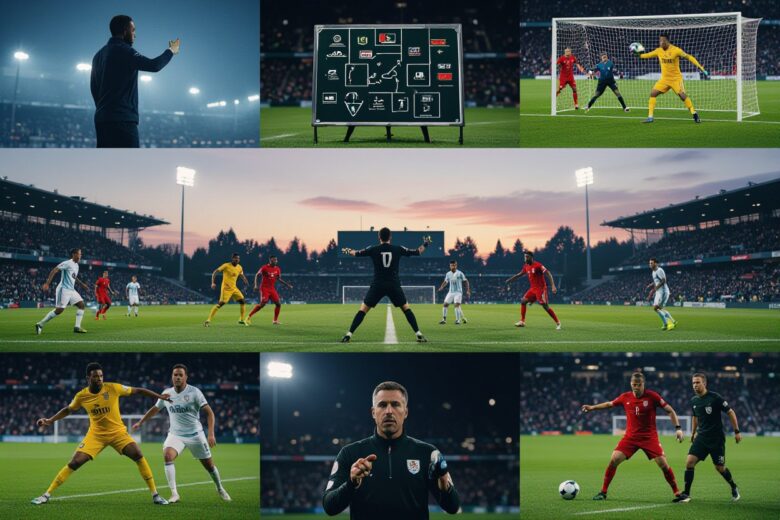You may overlook the work of roles that quietly shape results: defensive midfielders who shield defences and recycle possession, industrious full-backs who create width and scoring chances and become counter-attack threats, while set-piece specialists and analytics teams deliver the marginal gains that turn draws into wins. This post explains why these positions deserve more credit, how they influence tactics and outcomes, and what to watch for in your next match analysis.
The Unsung Heroes of Defense
You see defenders as blockers, but the most undervalued names are the organizers who dictate tempo and cover space: the center back who sweeps up danger, the full-back who flips a flank into an attack, the defensive midfielder who cancels threats. Examples like Virgil van Dijk (2019 PFA Player of the Year) show how a single defender can shift outcomes by combining game-reading with ball progression and leadership.
The Value of the Center Back
You rely on center backs to anchor rhythm and limit high-quality chances. Players such as Franco Baresi and Van Dijk turned anticipation into a statistical edge, often making multiple interceptions and 3–6 clearances per match while organizing the backline. Their impact isn’t just tackles: aerial dominance and the ability to step into midfield turn defensive moments into counter-attacking opportunities for your team.
Why Full-Backs Are More Than Just Wing Shuttlers
You judge modern full-backs by more than tracking wingers; they create overloads, unlock tight defenses, and supply decisive passes. Trent Alexander-Arnold’s double-digit assists seasons at Liverpool and Jordi Alba’s link play with Barcelona illustrate how full-backs can be primary creators, not mere wide defenders, transforming the width into a strategic weapon.
You should note full-backs also change team shape: inverted runs, underlapping bursts, and recovery speed force opponents to adjust. Stat lines like high chance-creation, consistent crossing, and stamina (many cover 10+ km per match at elite levels) show why managers build attacks around them. Offensive output and defensive recovery make full-backs game-defining pieces you can’t treat as secondary.
Beyond the Spotlight: The Importance of Fullbacks
Those relentless runs up and down the flank give your team a structural edge: fullbacks often cover 10–12 km per match and toggle between supplying crosses, underlaps and defensive recovery. Look at Dani Alves at Barcelona or João Cancelo at Manchester City — their positioning changes not only created overloads but also redefined how you exploit wide areas, turning a nominal defender into a primary creative outlet.
Overlapping Runs and Creating Width
Overlapping fullbacks force opponents to make decisions you can exploit: when Andy Robertson or Marcelo peel wide, you gain extra crossing lanes and create 2v1s down the flank that stretch compact defenses. Trainers measure success by chances from wide areas and by how often the winger can cut inside; effective overlaps increase both metrics, giving you the space to play incisive early crosses or drag central defenders out of position.
The Defensive Struggles and Tactical Flexibility
Sending a fullback forward often hands opponents a counter-attack route, leaving your center-backs facing 2v1 or 3v2 transitions if the covering midfielder isn’t positioned correctly. Managers like Pep Guardiola counter this by inverting fullbacks into midfield, which reduces exposure but demands a disciplined pivot—without that pivot you invite fast breaks and lose the defensive balance you need to protect leads.
Paying attention to personnel solves many risks: if you deploy an adventurous fullback, pair them with a defensive midfielder who can screen the half-space—Rodri at City is a textbook example, dropping to cover Cavani-sized gaps while Cancelo drifts inside. Tactical tweaks such as staggered pressing triggers, quicker recovery sprints (aiming to be back within 3–5 seconds of losing the ball) and zonal compactness turn a defensive vulnerability into an asset that enhances your formation’s flexibility.
The Playmaker in the Shadows
You notice the player who never chases headlines but reshapes every attack from deep, and your team functions differently when he’s on the ball. Examples like Sergio Busquets and Andrea Pirlo show how a single pivot can deliver >90% pass accuracy, orchestrate tempo shifts, and provide defensive cover while launching 30–40‑metre diagonal switches that break lines. Your awareness of that hidden influence changes how you evaluate possession stats versus actual control of a match.
Impact of the Deep-Lying Playmaker
You see the measurable effects in possession numbers: a top deep-lying playmaker commonly completes 50–80 passes per game, steps into the midfielder line to evade pressing, and increases team progressive passing. Busquets’ role at Barcelona repeatedly turned 60–70% possession into meaningful territory gains, and players like Xabi Alonso altered opposition structure by consistently playing long, accurate passes that force tactical adjustments.
Creating Opportunities Without Scoring
You often rely on these players for the pass before the assist—what analysts call the pre-assist—and for passes that lead directly to shots. Expect a solid deep-lying creator to register 2–3 passes leading to shots per 90, thread line-breaking through-balls, and produce situations where a striker’s expected goals spike because your midfielder removed multiple defenders with one pass.
You can quantify their contribution using metrics like progressive passes, passes into the final third, passes into the box, and secondary assists (hockey assists). Tracking xG chain shows how many scoring sequences they start; in many possession-heavy teams the deep-lying playmaker tops these charts, even if their traditional goals/assists column stays low. Your analysis should weight these indicators when judging a midfielder’s true offensive value.
Underappreciated Game Changers: Set-Piece Specialists
Set-piece specialists shift tight games by turning rehearsed moments into goals; you watch a corner or free-kick and see weeks of practice convert into points. Across top competitions, roughly one in three goals stems from set plays, so a reliable taker or a well-drilled routine becomes a season-long advantage that often flies under the radar.
The Art and Science of Set Pieces
Delivery, movement, and timing define success: you study trajectories, decoy runs, and targeted zones to exploit weak markers. Coaches now pair video analysis with biometric data to refine flight and pace, while specialists like Juninho, David Beckham, and James Ward‑Prowse demonstrate how pinpoint accuracy and practiced routines yield consistently high-value chances.
Impact on Match Outcomes
One free-kick or corner can flip a draw into three points or decide knockout ties; you see this in promotion battles and cup upsets where matches are settled by slim margins. Well-executed set plays supply decisive goals that change league tables and trajectories for clubs with otherwise similar xG profiles.
Quantifying that effect is straightforward: add even three extra goals across a season through improved set-piece work and you can realistically convert several draws to wins—often worth around six points or more. You can trace tangible returns when clubs hire dedicated set-piece coaches and witnesses examples like Juninho’s ~77 free-kick strikes or Ward‑Prowse’s consistent threat, which illustrate how specialists materially alter outcomes.
Goalkeepers: More Than Just Shot-Stopppers
You often judge keepers by spectacular saves, but modern goalkeepers shape games through distribution, sweeping actions, and set-piece control. Manuel Neuer redefined the sweeper-keeper, while Ederson’s long passes routinely turn defensive situations into counterattacks, giving your team a tempo advantage and reducing sustained pressure on your midfield.
The Importance of Distribution
You need a keeper who consistently turns turnovers into opportunities: crisp short passes to full-backs, quick switches of play, and accurate long diagonals that break opposition lines. Goalkeepers like Ederson and Alisson have contributed assists and high-value progressive passes, enabling your team to transition from defense to attack in seconds.
Organizing the Defense from the Back
You count on the goalkeeper’s voice to manage the line, call markers, and time offside traps; that direction turns disparate defenders into a synced unit. Goalkeepers such as Jan Oblak and Manuel Neuer read danger early and reposition their backline, which means your team faces fewer clear-cut chances and can defend with a higher defensive line.
Practically, your goalkeeper uses short commands — “line,” “man,” “ball” — plus hand signals to tighten gaps, assign zonal duties, and marshal bodies at corners. By stepping out to intercept through-balls (Neuer’s frequent forays outside his box are a clear example) and organizing who presses or holds, the keeper reduces one-on-one exposures and limits high-quality shots inside the box.
The Silent Leaders: Captains Without Goals
You often see names with single-digit season tallies who nevertheless steer matches. Players like Jordan Henderson, who captained Liverpool to the 2019 Champions League and the 2020 Premier League, or Giorgio Chiellini, who boasts over 116 Italy caps and lifted UEFA Euro 2020, prove that impact isn’t measured by goals. You notice their influence in structure, momentum shifts, and discipline — the unseen work that wins trophies more often than flashy scoring records.
Leadership Qualities Beyond the Statistics
You value captains who communicate constantly, manage the referee, and set training standards that raise team output. Examples include Carles Puyol’s relentless organizational voice at Barcelona and John Terry’s defensive discipline at Chelsea, both turning average defenders into cohesive units. You see these qualities reflected in metrics like reduced expected goals against or improved defensive win rates, even if their personal goal numbers remain low.
The Emotional and Tactical Influence on the Pitch
You feel the difference when a calm, commanding captain steadies the locker room and immediately alters the game plan—shifting a midfielder into a screening role, instructing fullbacks to sit, or directing a press after conceding. Those micro-adjustments change defensive shapes and pace, and in matches like the Euros or Champions League knockouts they often decide outcomes more than a late striker’s touch.
Digging deeper, you can point to concrete moments: a captain calling for zonal marking on a set piece, reducing opponent shot-quality by several percentage points, or urging a tactical press that forces turnovers in dangerous areas. You notice these interventions in win probability models and match footage—subtle orders, positional nudges, and emotional resets that turn pressure into control and opponents’ momentum into your advantage.
The Role of Coaches and Analysts: Behind the Curtain
You see managers on the touchline, but the season’s architecture is built by coaches and analysts who map training cycles, opposition briefs and recovery protocols. Video rooms stitch together heat maps and phase-of-play clips so you know which patterns to exploit; performance teams feed that into GPS and wellness data to plan minutes for each player. That quiet orchestration is where matches are won or lost long before kickoff.
Game Strategy: The Invisible Element of Success
Pressing triggers, positional rotations and set-piece scripts are often the invisible engines of victory; you notice Klopp’s gegenpress or Guardiola’s positional play not because of a single tweak but because of thousands of rehearsed micro-actions. Coaches design substitution windows, tailor counters to opponent weak spots and install contingency plans for weather or red cards, turning abstract strategy into repeatable match behaviors that produce measurable results.
The Impact of Data Analysis on Player Performance
Data gives you objective lenses: expected goals (xG) evaluates chance quality, tracking systems at ~10Hz measure sprint loads, and event data from Opta or StatsBomb quantifies decision-making under pressure. Analysts translate those streams into individualized drills, recovery schedules and scouting flags so you can prioritize players who offer the best return on minutes and reduce hidden performance drag.
Delving deeper, you see analytics informing recruitment and workload management together: xG profiles find forwards who consistently create high-quality chances, while GPS and heart-rate data guide weekly load adjustments to lower soft-tissue risk. Clubs like Brentford and FC Midtjylland used data-driven scouting to identify undervalued players and climb leagues, and advanced video tagging lets you pinpoint the exact moment a pressing line fails. The payoff is tangible—better signings, fewer preventable injuries, and clearer player development pathways.
Final Words
Hence you should reassess how much credit players in holding midfield, full-back, goalkeeper-sweeper roles, set-piece specialists and role-specific coaches receive; your appreciation of the game’s fine margins grows when you spot the tactical sacrifices, positioning discipline and off-the-ball intelligence that quietly win matches and shape team identity.




